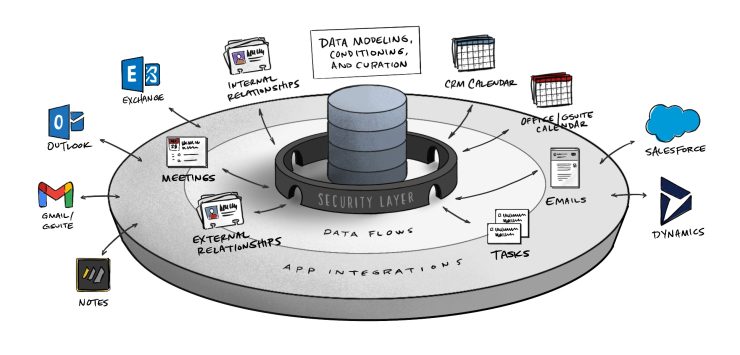Data is only as powerful as its weakest link, and for many companies – this weakness is the fact that their data is siloed in their different teams and departments. Without true unification, you aren’t able to extract the value that you should be getting. And instead, you end up with processes and workflows that duplicate effort, confuse clients, and ultimately slow your company’s growth.
In this article, we’ll explore the problem of data silos and how you can go about eradicating them so that you can take your organization to the next level.
1. What Are Data Silos?
Data silos can encompass a wide range of different things, but typically they refer to a dataset or repository of information that is only accessible to one team or department and not to the rest of the organization. This silo can be conscious or unconscious and it often leads to inefficiencies, duplication, and a lack of synergy between teams that ultimately harms the end result both for customers and for the organization itself.
For example, if a company has all its customer information in a CRM system that only the sales team can access, then that data is siloed and cannot be used efficiently by other teams such as operations, customer service, and the like.
2. What Causes Data Silos?
Whether we like it or not, data silos are often a natural by-product of a company growing and getting more complex. As you build specialized teams that handle specific components of your operations, they start to act independently, and they build the data capabilities that they need to succeed. With so many moving parts, these can become siloed because there is no inbuilt incentive for those teams to share the data that they’re creating in a proactive way. They are simply focused on doing what they’ve been tasked with doing.
This is compounded by the fact that modern companies often rely on various SaaS products for capturing and managing data – many of which don’t integrate with one another. So, as you build your technology stack, there are natural silos that develop because one platform doesn’t talk to another. It’s impractical and expensive to give everyone access to every portal and so you end up with data that only exists in one place – for very specific use cases.

Without someone responsible for proactively fighting these data siloes from a bigger picture perspective, these are simply growing pains that will affect every medium and large company as they scale.
3. What are the Problems with Data Silos?
There are a number of common problems with data silos, varying in seriousness, but all serving to slow growth and reduce inefficiency. Some of these include the following:
- Poorer decision-making. Being able to make decisions based on data rather than intuition is a significant advantage in a fast-moving business environment. Therefore, if you aren’t making full use of the data at your disposal, you’re leaving value on the table. Data silos prevent you from leveraging your data to its full potential and this results in diminished decision-making capabilities.
- Harms collaboration between teams. Inter-disciplinary collaboration is paramount for delivering a consistent customer experience and for achieving the requisite internal efficiencies to make an organization tick. When teams aren’t able to work from the same source data, it makes this collaboration much more difficult. It creates unnecessary friction that simply gets in the way.
- Higher technology costs. The more disparate your data is, the more you’re spending on technology to manage, store, and utilize it. Every silo that you create creates a drag on profitability and it results in unnecessary duplication of resources. This might not seem significant in isolation – but when it compounds to the group level, this can be a serious concern.
- Unleveraged insights. One of the biggest advantages of a well-aligned data warehouse is that you can find unique insights that draw from all of your data which can then be used to push the company forward. When your data is siloed you simply don’t get that benefit and you leave a lot on the table in terms of opportunity cost.
- Disjointed customer experience. Your customers will also feel the pinch of data silos because you don’t have a single view of the customer that can be used to manage their affairs. There is a risk of confusion, miscommunication, and a lack of contextual understanding of a client – all of which will degrade the overall experience.
- Data inconsistencies. When your data is not in sync you run the risk of inconsistencies and version control becoming something that wastes time and resources when you inevitably have to fix things. This also makes it more difficult to spot potential errors when different data sets are following different guidelines and rules.
As you can see, data silos can be quite damaging on an organizational level because of the inefficiencies that they create as well as the opportunities for better decisions that are forgone. As such, it’s crucial that you work to eliminate them or at least to mitigate their impact if you want your company to operate at its best.
4. How Do You Detect Data Silos?
In order to detect data silos, you need to have a good grasp of your current data processes, the workflows across your teams, and the technology that you use internally to do business. A good place to start is to speak with each of the individual teams within your organization and ask them about their data practices.
What software do they use?
What data do they rely on?
Where do they get their inputs?
Where do they send their outputs?
What data do they wish they had access to?
Questions like these help to get to the root of the data-specific components of what they do and when you do this with enough teams – you’ll start to identify where things are siloed.
Ideally, you want to create a detailed process map that lays out how things are currently structured at a big picture level – so that you can deploy your resources appropriately. Once you have this, you can then strategize as to what the best methods will be to eliminate those silos and to align your different operational components with one another.
Because this process is going to require a lot of change management, it’s important that you take the time to talk to all your people and get their insights on where the problems are and what would make their lives easier. They’re closer to the ground than you might be and so you really should be trying to understand exactly what they’re dealing with before you start coming up with solutions.
5. How Do You Get Rid of Data Silos?
There are a number of practical solutions that you can implement that will help to break down your data silos and prevent them from having the outsized impact they might be having currently. Here are some of the key ones to consider:
- Implement robust data governance principles. Setting the right policies and procedures around your data is a great first step to ensure that everyone is on the same page. By having consistent guidelines that can be enforced across all your departments, it reduces inconsistency and makes it easier to align data as and when required.
- Centralize all your data into one singular data warehouse. Being able to centralize everything into one system would obviously be the holy grail in terms of achieving alignment – but it’s exceptionally difficult to do – especially if you’re working from legacy systems. Full centralization makes it difficult to use combinations of software products and it requires a lot of maintenance to keep things working as they need to. But, if you can pull this off – it’s a huge competitive advantage.
- Integrate your software products. A more realistic solution for most enterprises is to integrate their various software tools so that data can seamlessly flow between them. This allows you to maintain your existing infrastructure while still getting the benefits of integrated data. This is exactly what we do here at Riva and it’s proven to be immensely valuable for our client base.

Integration software like Riva’s sync platform shares and integrates data between the most common CRM systems and office / email platforms.
6. Conclusion
There you have it! Hopefully, this guide has helped to illustrate the challenges of data silos and what you can do as an organization to eradicate them. This is something that is constantly evolving so it will require consistent scrutiny – but the benefits are well worth it.
Here at Riva, we help clients to sync and integrate various software platforms including Salesforce, Microsoft Exchange, and many more. Our focus is on highly scalable, secure integrations that eliminate data silos and transform your operations from the inside. If you’d like to explore more, you can contact us here. We’d love to see how we can help!

